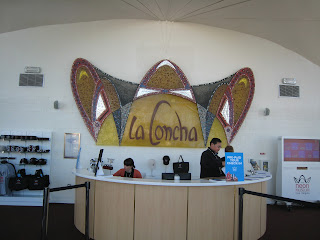If you're interested in art, design or Vegas casino history, then the Neon Boneyard is a must-see on your next Vegas trip.
The Neon Boneyard is part of the Neon Museum, which comprises the Neon Boneyard, the Downtown Gallery (East Freemont Street) and the Las Vegas Sign Project, (Las Vegas Blvd., between Sahara and Washington).
The later two are installations in public areas so you can see the signs at any time. They are also functioning, so you can see them lit up at night.
The Neon Boneyard is located a few minutes from Downtown Las Vegas, right before Cashman Field. Its collection provides a colorful history of Vegas with neon signs that graced casinos past.
One-hour guided tours are offered throughout the day, and you must make reservations. This museum requires you to take a guided tour; you can't just view the signs on your own. The Bone Yard, which isn't very large, is completely outdoors and covered shoes are recommended. If you're visiting during the summer, a hat, sunglasses, sunscreen and plenty of water are a must.
Here's some highlights from my visit:
On your way to the Neon Boneyard, you'll see this glass slipper in the center median of the road. It's from the Silver Slipper casino, which was located on the Strip, across the street from the Desert Inn.
The entrance of the museum is actually the lobby of the old La Concha Motel, which closed in 2003.
The lobby of the Neon Boneyard. The sign mounted behind the desk is from the La Concha Motel, obviously.
The first piece you'll see when you head outside is from Binon's Horseshoe. The museum offers night tours, and this is one of several functioning signs. The sign is installed vertically, up against the side of the building; however, this piece actually hung above the entrance to the casino. Notice the "H's" of the sign.
Binion's Horseshoe, the casino that put Texas Hold 'Em on the map. Now it's simply known as Binion's.
I've never been to the Frontier, which was located at the north end of the Strip, adjacent to Stardust. The thing that stands out the most about it in my mind was the strike its workers were on. I would see them picketing outside the casino on practically every trip until they closed. They were on strike for years.
The Sahara sign is a recent addition. We used to go there for their cheap blackjack tables. The new owners are keeping the structure, but will do an extensive re-model and re-branding. Can't wait to see it when it opens!
The Tropicana recently underwent a renovation. They kept the name and the theme, but the logo was updated to a script-y red font version. I love the remodel. The casino is extremely bright, airy and clean, and the air conditioning has a slight coconut scent to it. One thing they did keep was all the stained glass above the table games.
The Fitzgerald, located in Downtown, was recently re-modeled and re-branded The D Las Vegas. Pictured here are the "coins" from the old signage. They replaced the Krispy Kreme store with a hot dog place, and I'm sure gonna miss getting those donuts in Downtown.
Yet another casino that underwent a re-model and re-brand -- the Aladin, which is now Planet Hollywood. This Aladin's lamp sat above the casino floor
When Vegas went through it's "family friendly" phase, this pirate was the face of Treasure Island, now known as TI. The pirate is installed looking up to the sky (I didn't forget to rotate the picture).
Me, standing along the path of the Boneyard. As you can see, signs are stacked up against each others on both sides.
And last, but not least, the La Concha Motel sign. (Notice the "coin" from Caesar's Palace to the right.)
This post is just the tip of the iceberg. Our docent was very knowledgable and provided us with a lot of facts about the signs - including background about the designers and the Young Electric Sign Company - the historical significance of many of the casinos and interesting anecdotes, including several about eccentric millionaire Howard Hughes.













I have to agree, those docents sure are full of interesting, historical information!
ReplyDelete